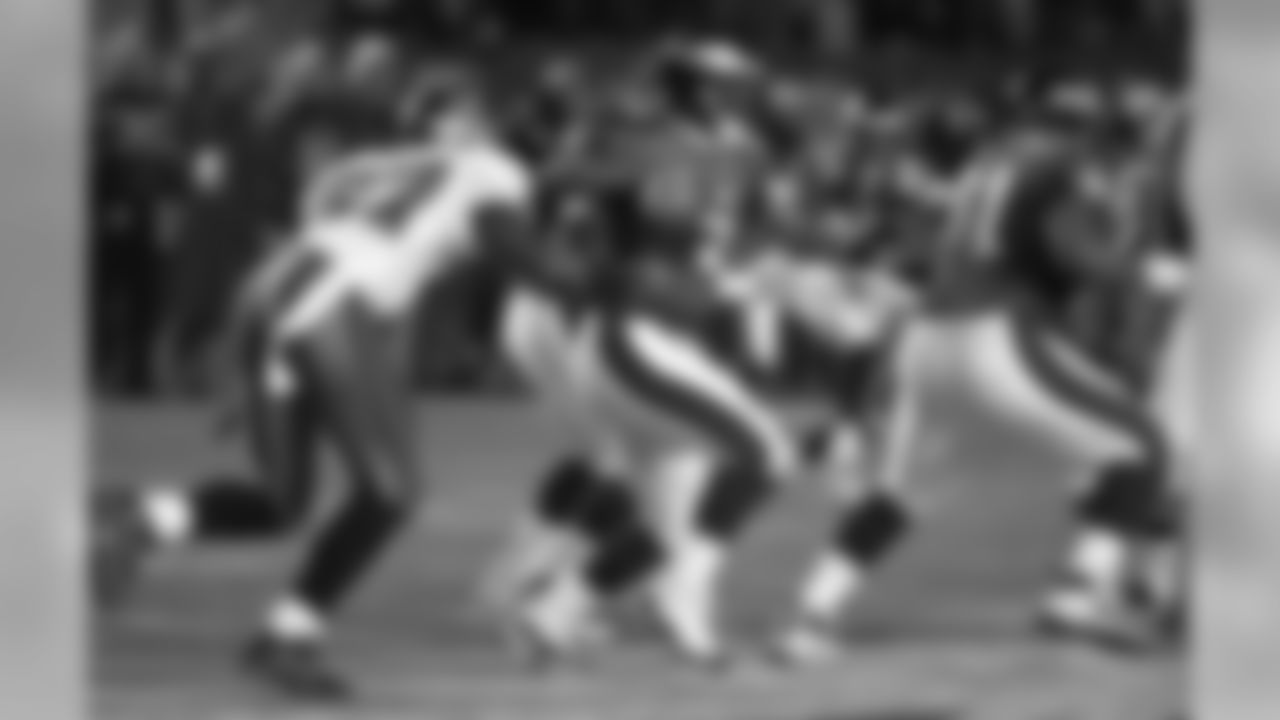Statistics can help illuminate the game of football…or they can take us down a misleading path. As Tampa Bay Buccaneers Head Coach Lovie Smith said: "I believe in stats, but it's [which] stats."
Smith, for instance, doesn't pay much attention to the NFL's defensive rankings, since they are based on yards, which he considers a meaningless measure. When he shares defensive stats with his team, he focuses on points allowed, takeaways, scoring on defense and red zone proficiency.
Here on Buccaneers.com, we unabashedly love stats, but we also understand the need to wield them wisely. Sometimes, we can get a better feel for why the team is performing as it is by going a little deeper into the numbers. Other times, we simply want to point out a few numbers we consider interesting, and hope you will find it interesting as well.
That's our goal with Football Geekery. Each week, we're going to give you a sampling of statistical and/or historical analysis, hopefully in a way that is relevant to the Buccaneers' current state of affairs. Let's get started.
1. Last-Second Saves
Bradley McDougald secured the third interception of his young career last Sunday against Dallas, and it's safe to say it was his biggest pick so far. McDougald's swipe of a long Matt Cassel pass intended for Dez Bryant in the end zone put the finishing touches on Tampa Bay's 10-6 comeback victory over the Cowboys.
Tampa Bay's offense had scored the go-ahead touchdown with 54 seconds left in the game and that left the Bucs' defense needing one final stop to secure the win. An unnecessary roughness penalty allowed the Cowboys to start their final drive just six yards shy of midfield, and they quickly got across midfield before spiking the ball with 28 seconds to go. On the next play, Cassel rolled out to his right to buy time and, from approximately midfield, threw deep down the middle in Bryant's direction. Had Cassel and Bryant hooked up on that play, Dallas almost certainly would have won the game; instead, the Bucs' offense was able to kneel to kill the game's final 14 seconds.
Photos of Buccaneers vs. Eagles matchups through the years.

















Tampa Bay's defense had been lacking in such "finishing" plays during several close losses earlier in the season, so McDougald's game-saving play was very encouraging. In a larger sense, however, that interception, given its specific circumstances, was also something of a rarity in franchise history.
Specifically, McDougald's play marked just the 12th time in the Bucs' 40 seasons that a player has intercepted a pass in the game's final 30 seconds to preserve a win that was decided by a single score. That would include any game the Buccaneers won by seven points or less before the NFL's adoption of the two-point conversion in 1994 and any game decided by eight points or less thereafter.
The Bucs first got such a game-clinching interception in the final 30 seconds against the Rams early in the 1980 season. Before McDougald's play on Sunday, the most recent such occurrence for the Buccaneers had been in 2007, against the Washington Redskins. Here are all 12 of those contests and their in-game details, listed in chronological order.
- Tampa Bay 10, L.A. Rams 9 (Sept. 9, 1980)…CB Norris Thomas intercepts Rams QB Vince Ferragamo at the Bucs' 22 with seven seconds left.
- Tampa Bay 21, Minnesota 13 (Sept. 5, 1981)…S Neal Colzie intercepts Vikings QB Steve Dils at the Bucs' 18 and returns it 82 yards for a touchdown with 21 seconds left. Despite the eight-point win, this was a one-score game before Colzie's play in the final 30 seconds.
- Tampa Bay 23, Miami 17 (Nov. 29, 1982)…S Mike Washington intercepts Dolphins QB Don Strock at the Bucs' goal line on the last play of the game, after the Dolphins had recovered an onside kick.
- Tampa Bay 24, Buffalo 23 (Dec. 19, 1982)…S Neal Colzie intercepts Bills QB Joe Ferguson at the Bucs' 24 with three seconds to play. Though it technically counts, this was a Hail Mary pass thrown from the Bills' 34-yard line so the play bears little resemblance to the others on the list.
- Tampa Bay 23, Detroit 21 (Dec. 26, 1982)…CB Norris Thomas intercepts Lions QB Gary Danielson at the Bucs' 48 with three seconds lift. Like the above occurrence, this was also a very low-percentage Hail Mary attempt.
- Tampa Bay 35, Minnesota 31 (Oct. 7, 1984)…CB John Holt intercepts Vikings QB Tommy Kramer at the Bucs' 48 on a play that had 16 seconds left at the snap.
- Tampa Bay 7, Phoenix 3 (Dec. 27, 1992)…CB Milton Mack intercepts Cardinals QB Timm Rosenbach in the end zone with three seconds left.
- Tampa Bay 17, Kansas City 10 (Nov. 14, 1999)…LB Hardy Nickerson intercepts Chiefs QB Elvis Grbac in the end zone with 17 seconds left.
- Tampa Bay 16, Miami 13 (Dec. 10, 2000)…S Damien Robinson intercepts Dolphins QB Jay Fiedler at the Bucs' nine-yard line with 14 seconds left.
- Tampa Bay 12, Carolina 9 (Oct. 27, 2002)…S John Lynch intercepts Panthers QB Randy Fasani at the Bucs' five-yard line on the last play of the game. This, too, was a desperation Hail Mary attempt.
- Tampa Bay 19, Washington 13 (Nov. 25, 2007)…CB Brian Kelly intercepts Redskins QB Jason Campbell in the end zone with 17 seconds to play.
- Tampa Bay 10, Dallas 6 (Nov. 15, 2015)…S Bradley McDougald intercepts Cowboys QB Matt Cassel in the end zone with 14 seconds to play.
So McDougald finds himself on a list of just 10 players in the entire history of the franchise who have intercepted a pass in the final 30 seconds of a game to preserve a one-score win, as Norris Thomas and Neal Colzie appear on that list twice.
PHOTOS: FLORIDA HOSPITAL FAN FRIDAY
We noted several instances above in which the play in question occurred on a Hail Mary attempt, which doesn't feel like the same category of play but technically fits the criteria. It is possible to narrow this list down a bit more, however. If one only includes interceptions that were made in the end zone, then McDougald now finds himself on a more exclusive list of just five players, joining Mike Washington, Milton Mack, Hardy Nickerson
2. Play by Play
Tampa Bay's offense with rookie quarterback Jameis Winston at the helm has shown signs that it could develop into one of the most productive attacks in team history. In one category, in fact, Winston's crew has a chance to break the franchise's all-time single-season record: yards per play.
Through nine games this season, the Buccaneers have averaged 5.66 yards per play; if maintained, that would be the second-best single-season mark in team annals, just surpassing the 5.61 yards per play the 2010 team put up. A slight uptick in per-play production could put the 2012 mark of 5.77 in jeopardy at the top of that list.
Meanwhile, Tampa Bay's defense has allowed 5.22 yards per play this year, which is not particularly close to the team record. In fact, it would rank 26th out of the Bucs' 40 seasons if it stayed the same through 16 contests. Not surprisingly, the top of that list is dominated by teams from the late '70s and early '80s; the Bucs developed their first strong defense in that span, during an era in offense's league-wide were a lot less prolific than they are in the current era. The famous Bucs defense of the Super Bowl era essentially rounds out the top 10.
The best times for the Buccaneers have come when those two numbers have peaked at the same time. Tampa Bay first made the playoffs in just its fourth season of existence, in 1979, thanks in large part to a defense that held opponents to 3.89 yards per play. The '79 offense was not exactly a high-flying attack, but it did average 4.79 yards per play, which was a huge jump up from its '78 mark of 3.95. Combining those two stats, the 1979 Buccaneer team averaged 0.90 more yards per play on offense than it allowed on defense, the largest positive difference between those two numbers of any season in franchise annals.
Having a positive difference between yards per play and yards allowed per play has been a good harbinger of a successful season for the Buccaneers. In fact, when Tampa Bay's 40 seasons (including the current one) are ranked by that difference, the first four years on the list are playoff campaigns, including the 2002 Super Bowl season. The +0.44 difference for the current team would rank eighth in team history, if maintained. The top 12 teams on the list, not including the unfinished 2015 campaign, have a combined winning percentage of .572.
Here are the Bucs' 40 seasons, ranked in descending order by differential between offensive and defensive yards per play.
|
Season |
Off. Y/P |
Def. Y/P |
Diff. |
W |
L |
T |
Pct. |
|
1979 |
4.79 |
3.89 |
0.90 |
10 |
6 |
0 |
.625 |
|
2007 |
5.36 |
4.56 |
0.81 |
9 |
7 |
0 |
.563 |
|
2002 |
4.89 |
4.20 |
0.69 |
12 |
4 |
0 |
.750 |
|
1981 |
5.43 |
4.76 |
0.67 |
9 |
7 |
0 |
.563 |
|
2003 |
5.26 |
4.64 |
0.62 |
7 |
9 |
0 |
.438 |
|
1982 |
4.93 |
4.33 |
0.60 |
5 |
4 |
0 |
.556 |
|
2004 |
5.23 |
4.74 |
0.49 |
5 |
11 |
0 |
.313 |
|
2015 |
5.66 |
5.22 |
0.44 |
4 |
5 |
0 |
.444 |
|
2000 |
4.84 |
4.58 |
0.25 |
10 |
6 |
0 |
.625 |
|
2010 |
5.61 |
5.37 |
0.24 |
10 |
6 |
0 |
.625 |
|
2005 |
4.79 |
4.68 |
0.11 |
11 |
5 |
0 |
.688 |
|
1997 |
4.78 |
4.71 |
0.07 |
10 |
6 |
0 |
.625 |
|
1998 |
4.75 |
4.70 |
0.06 |
8 |
8 |
0 |
.500 |
|
1988 |
5.07 |
5.03 |
0.04 |
5 |
11 |
0 |
.313 |
|
2008 |
5.22 |
5.18 |
0.04 |
9 |
7 |
0 |
.563 |
|
1980 |
4.91 |
4.97 |
-0.06 |
5 |
10 |
1 |
.344 |
|
1999 |
4.29 |
4.38 |
-0.09 |
11 |
5 |
0 |
.688 |
|
2012 |
5.77 |
5.90 |
-0.12 |
7 |
9 |
0 |
.438 |
|
1978 |
3.95 |
4.13 |
-0.18 |
5 |
11 |
0 |
.313 |
|
2001 |
4.49 |
4.90 |
-0.41 |
9 |
7 |
0 |
.563 |
|
1994 |
5.00 |
5.41 |
-0.41 |
6 |
10 |
0 |
.375 |
|
1987 |
4.59 |
5.01 |
-0.41 |
4 |
11 |
0 |
.267 |
|
1984 |
4.88 |
5.30 |
-0.42 |
6 |
10 |
0 |
.375 |
|
1992 |
4.80 |
5.26 |
-0.46 |
5 |
11 |
0 |
.313 |
|
1983 |
4.45 |
4.94 |
-0.48 |
2 |
14 |
0 |
.125 |
|
2014 |
4.99 |
5.53 |
-0.54 |
2 |
14 |
0 |
.125 |
|
1990 |
4.91 |
5.47 |
-0.56 |
6 |
10 |
0 |
.375 |
|
1989 |
4.72 |
5.32 |
-0.59 |
5 |
11 |
0 |
.313 |
|
1996 |
4.33 |
4.93 |
-0.60 |
6 |
10 |
0 |
.375 |
|
1993 |
4.54 |
5.19 |
-0.65 |
5 |
11 |
0 |
.313 |
|
1991 |
4.34 |
5.03 |
-0.69 |
3 |
13 |
0 |
.188 |
|
2006 |
4.45 |
5.19 |
-0.75 |
4 |
12 |
0 |
.250 |
|
1985 |
4.85 |
5.62 |
-0.77 |
2 |
14 |
0 |
.125 |
|
1995 |
4.73 |
5.54 |
-0.81 |
7 |
9 |
0 |
.438 |
|
2009 |
4.79 |
5.63 |
-0.84 |
3 |
13 |
0 |
.188 |
|
1977 |
3.23 |
4.15 |
-0.92 |
2 |
12 |
0 |
.143 |
|
2013 |
4.52 |
5.46 |
-0.94 |
4 |
12 |
0 |
.250 |
|
2011 |
5.29 |
6.30 |
-1.01 |
4 |
12 |
0 |
.250 |
|
1986 |
4.50 |
5.97 |
-1.47 |
2 |
14 |
0 |
.125 |
|
1976 |
3.50 |
5.15 |
-1.65 |
0 |
14 |
0 |
.000 |
3. Nowhere to Run
Whatever the Buccaneers did during their Week Six bye, it has helped the team's run defense. Despite facing several top rushing attacks (Atlanta and Dallas), the Buccaneers have been one of the NFL's best teams at stopping the ground game in the four weeks since they came back from their break.
Below are charts ranking the top 10 teams in five different rush defense categories from Weeks 7-10: yards allowed per game, yards allowed per carry, rushing touchdowns allowed, runs of 10 or more yards allowed and percentage of total runs on which 10 or more yards was allowed. The Buccaneers rank no worse than third in all of those categories. (Note that none of these numbers include the statistics from the Week 11 Thursday Night Game between Tennessee and Jacksonville.)
The charts below also show each team's win-loss record during that four week span, to give an idea how strong rush defense does or does not correlate with victory.
Rushing Yards Allowed Per Game
|
Rk. |
Team |
Yds/G |
Yds/Att. |
TD |
10+ |
10+% |
W |
L |
|
1 |
New England Patriots |
55.3 |
2.76 |
1 |
3 |
3.8 |
4 |
0 |
|
2 |
Arizona Cardinals |
69.7 |
3.87 |
3 |
9 |
16.7 |
3 |
0 |
|
3 |
Tampa Bay Buccaneers |
76.8 |
3.07 |
1 |
5 |
5.0 |
2 |
2 |
|
4 |
Jacksonville Jaguars |
77.7 |
3.03 |
2 |
8 |
10.4 |
2 |
1 |
|
5 |
Cincinnati Bengals |
89.0 |
4.38 |
0 |
7 |
11.5 |
2 |
1 |
|
6 |
Tennessee Titans |
90.8 |
3.16 |
3 |
10 |
8.7 |
1 |
3 |
|
7 |
Pittsburgh Steelers |
92.5 |
4.07 |
2 |
11 |
12.1 |
2 |
2 |
|
8 |
New York Jets |
95.0 |
4.42 |
1 |
15 |
17.4 |
1 |
3 |
|
9 |
Kansas City Chiefs |
99.0 |
5.50 |
1 |
8 |
14.8 |
3 |
0 |
|
10 |
Seattle Seahawks |
102.3 |
3.94 |
1 |
5 |
6.4 |
2 |
1 |
The top five teams in rushing yards allowed per game have combined for a 13-4 record in that same four-week span. Only New England and Arizona have been better than the Bucs in that time, and they are a combined 7-0.
Yards Allowed Per Rush
|
Rk. |
Team |
Yds/G |
Yds/Att. |
TD |
10+ |
10+% |
W |
L |
|
1 |
New England Patriots |
55.3 |
2.76 |
1 |
3 |
3.8 |
4 |
0 |
|
2 |
Jacksonville Jaguars |
77.7 |
3.03 |
2 |
8 |
10.4 |
2 |
1 |
|
3 |
Tampa Bay Buccaneers |
76.8 |
3.07 |
1 |
5 |
5.0 |
2 |
2 |
|
4 |
Tennessee Titans |
90.8 |
3.16 |
3 |
10 |
8.7 |
1 |
3 |
|
5 |
Denver Broncos |
105.3 |
3.40 |
3 |
12 |
12.9 |
1 |
2 |
|
6 |
Green Bay Packers |
111.7 |
3.49 |
4 |
10 |
10.4 |
0 |
3 |
|
7 |
St. Louis Rams |
104.5 |
3.57 |
3 |
12 |
10.3 |
2 |
2 |
|
8 |
Atlanta Falcons |
109.0 |
3.80 |
1 |
9 |
10.5 |
1 |
2 |
|
9 |
Arizona Cardinals |
69.7 |
3.87 |
3 |
9 |
16.7 |
3 |
0 |
|
10 |
San Diego Chargers |
103.7 |
3.89 |
3 |
8 |
10.0 |
0 |
3 |
The Bucs were allowing 4.05 yards per rush before their bye week, which was still good enough for 11th in the league. Impressively, they've shaved nearly an entire yard off that average since.
Rushing Touchdowns Allowed
|
Rk. |
Team |
Yds/G |
Yds/Att. |
TD |
10+ |
10+% |
W |
L |
|
1t |
Cincinnati Bengals |
89.0 |
4.38 |
0 |
7 |
11.5 |
2 |
1 |
|
1t |
New Orleans Saints |
120.8 |
5.19 |
0 |
13 |
14.0 |
2 |
2 |
|
3t |
New England Patriots |
55.3 |
2.76 |
1 |
3 |
3.8 |
4 |
0 |
|
3t |
Tampa Bay Buccaneers |
76.8 |
3.07 |
1 |
5 |
5.0 |
2 |
2 |
|
3t |
Atlanta Falcons |
109.0 |
3.80 |
1 |
9 |
10.5 |
1 |
2 |
|
3t |
Seattle Seahawks |
102.3 |
3.94 |
1 |
5 |
6.4 |
2 |
1 |
|
3t |
Baltimore Ravens |
107.0 |
4.22 |
1 |
7 |
9.2 |
1 |
2 |
|
3t |
New York Jets |
95.0 |
4.42 |
1 |
15 |
17.4 |
1 |
3 |
|
3t |
Chicago Bears |
106.0 |
4.89 |
1 |
9 |
13.8 |
2 |
1 |
|
3t |
Houston Texans |
136.0 |
5.44 |
1 |
9 |
12.0 |
2 |
1 |
|
3t |
Kansas City Chiefs |
99.0 |
5.50 |
1 |
8 |
14.8 |
3 |
0 |
|
3t |
Washington Redskins |
169.7 |
5.53 |
1 |
13 |
14.1 |
2 |
1 |
In general, this is probably the least likely of these five stats to be predictive of wins and losses, because a team can give up a lot of rushing yards and a lot of passing touchdowns, and that's a bad combination. But the Bucs still find themselves in the company of such teams as 9-0 New England and 8-1 Cincinnati.
Rushes of 10 or More Yards Allowed
|
Rk. |
Team |
Yds/G |
Yds/Att. |
TD |
10+ |
10+% |
W |
L |
|
1 |
New England Patriots |
55.3 |
2.76 |
1 |
3 |
3.8 |
4 |
0 |
|
2 |
Tampa Bay Buccaneers |
76.8 |
3.07 |
1 |
5 |
5.0 |
2 |
2 |
|
3 |
Seattle Seahawks |
102.3 |
3.94 |
1 |
5 |
6.4 |
2 |
1 |
|
4 |
Cincinnati Bengals |
89.0 |
4.38 |
0 |
7 |
11.5 |
2 |
1 |
|
5 |
Baltimore Ravens |
107.0 |
4.22 |
1 |
7 |
9.2 |
1 |
2 |
|
6 |
San Francisco 49ers |
130.0 |
4.06 |
3 |
7 |
7.3 |
1 |
2 |
|
7 |
Kansas City Chiefs |
99.0 |
5.50 |
1 |
8 |
14.8 |
3 |
0 |
|
8 |
Jacksonville Jaguars |
77.7 |
3.03 |
2 |
8 |
10.4 |
2 |
1 |
|
9 |
San Diego Chargers |
103.7 |
3.89 |
3 |
8 |
10.0 |
0 |
3 |
One of the reasons the Bucs have kept their rush defense numbers low is that they haven't allowed a lot of breakaway runs. Only New England has allowed fewer 10+-yard runs over the last month.
Percentage of Rushes Against That Gained 10 or More Yards
|
Rk. |
Team |
Yds/G |
Yds/Att. |
TD |
10+ |
10+% |
W |
L |
|
1 |
New England Patriots |
55.3 |
2.76 |
1 |
3 |
3.8 |
4 |
0 |
|
2 |
Tampa Bay Buccaneers |
76.8 |
3.07 |
1 |
5 |
5.0 |
2 |
2 |
|
3 |
Seattle Seahawks |
102.3 |
3.94 |
1 |
5 |
6.4 |
2 |
1 |
|
4 |
San Francisco 49ers |
130.0 |
4.06 |
3 |
7 |
7.3 |
1 |
2 |
|
5 |
Carolina Panthers |
112.0 |
4.27 |
2 |
9 |
8.6 |
4 |
0 |
|
6 |
Tennessee Titans |
90.8 |
3.16 |
3 |
10 |
8.7 |
1 |
3 |
|
7 |
Baltimore Ravens |
107.0 |
4.22 |
1 |
7 |
9.2 |
1 |
2 |
|
8 |
San Diego Chargers |
103.7 |
3.89 |
3 |
8 |
10.0 |
0 |
3 |
|
9 |
St. Louis Rams |
104.5 |
3.57 |
3 |
12 |
10.3 |
2 |
2 |
|
10 |
Jacksonville Jaguars |
77.7 |
3.03 |
2 |
8 |
10.4 |
2 |
1 |
|
11 |
Green Bay Packers |
111.7 |
3.49 |
4 |
10 |
10.4 |
0 |
3 |
Since some teams have played three games and others have played four in the last four weeks, the percentage of runs that gained 10 or more yards is a more telling statistic. It's New England #1 at 3.8%, the Bucs second at 5.0% and the numbers go up steeply from there. Even the team ranked eighth on the list has given up a percentage of 10+-yard runs twice as high as the Buccaneers.
























